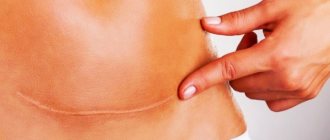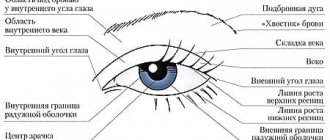Consultation with plastic surgeons with over 20 years of experience – free! Sign up by phone. Waiting for you! Childbirth is a joyful event in the life of any woman. However, motherhood leaves some imprint on a woman’s figure. Therefore, after the second or third birth, many patients resort to tummy tuck
for the purpose of correcting the anterior abdominal wall, improving its contours, removing excess tissue, stretch marks and stretch marks.
Why do changes occur?
Deformation of the abdominal walls after childbirth may be a consequence of general muscle weakening (diastasis), which progresses during pregnancy. During gestation and growth of the fetus, micro tears appear in the subcutaneous connective tissue, contributing to the loss of skin elasticity and the formation of excess, stretch marks and stretch marks.
With minor changes in the abdominal area, in the first months after childbirth
Abdominal strengthening exercises are effective. In more complex cases, postpartum exercise gives some result, but not one that would completely satisfy the patient - a flat stomach.
And here there is only one way out: abdominoplasty or abdominal liposuction will help restore beauty. Operations of this type are well-established, but surgeons certainly discuss the methodology and progress of their implementation with patients before operations.
Plastic surgery after childbirth. (Chest, abdomen, intimate area)
Have you ever heard this: “I don’t want a child, I’m afraid of ruining my figure”? Surely I had to. Many women absolutely consciously accept that their figure will change after childbirth, and for some the consequences become an unpleasant surprise. The good news is that you no longer have to put up with changes that don't suit you. Every woman can regain her figure after childbirth or even improve it (many, having seen how beautiful their breasts look, enlarged while breastfeeding, decide to “fix the result” with mammoplasty).
In any case, today every woman, regardless of the number of children, deserves to be a slim and beautiful mother.
The three main problem areas for women after the end of lactation are:
- breast,
- stomach,
- intimate area.
After the end of the breastfeeding period, the woman begins to take care of her figure and pays more attention to the problems that have arisen. These changes are quite natural and almost everyone experiences them. To those young mothers who are unhappy with the changes that have happened to them, we offer our advice and assistance.
Types of mini abdominoplasty
There are several types of mini-abdominoplasty, which differ from each other in the technique of execution and the tasks to be solved:
- mini abdominoplasty with an incision in the bikini line area is a standard technique for correcting the lower abdomen, which is used to eliminate severe sagging skin and/or a scar after a cesarean section;
- periumbilical mini-abdominoplasty – incisions are made around the navel area in the shape of an ellipse; this surgical technique is used to eliminate stretch marks and sagging skin;
- mini-abdominoplasty with skin de-epidermization - this technique does not involve incisions or correction of the volume of subcutaneous fat and is limited to the removal of the superficial layer of skin on the abdomen to eliminate minor stretch marks.
Breast surgery after childbirth.
During the period of feeding a baby, the breasts, as is known, increase in size, and then return to their previous size, but, unfortunately, do not always retain their beautiful shape. And a young mother really wants to have young, firm breasts. Most often, in this case, a breast lift is required, which can be carried out either with its simultaneous enlargement or without the installation of implants .
It happens that a girl was quite happy with her small breasts until she saw them while breastfeeding. Usually the breast increases by 1-2 sizes. And many people really like it. There is a sort of natural “trying on” of the new breast. What is called “feel the difference”! And it is quite natural that when, after weaning a child, only memories remain of luxurious forms, women turn to us. They no longer have doubts about whether they need breast augmentation. They just want to forever return those beautiful forms that motherhood temporarily gave them!
Breast plastic surgery after childbirth is one of the main areas of work of Svetlana Vyacheslavovna Gagarina. In our clinic you can undergo a breast lift to quickly restore its previous shape. You can also undergo breast augmentation and give it the desired volume. We also perform breast reduction for those women who require it after childbirth or for other reasons.
Ideally selected high-quality breast implants, precise and professional work of a plastic surgeon, thin and invisible seams - this is what will help you return to an active life and enjoy not only the happiness of motherhood, but also confidence in your own attractiveness.
Rehabilitation
How long does rehabilitation take for mini abdominoplasty? From 2 to 3 weeks, which is significantly less than recovery with classic abdominoplasty. For the first 24 hours, the patient remains in bed in a plastic surgery clinic. Patients are discharged home only 2-3 days after mini-abdominoplasty. The cost of surgery may increase due to additional hospital stay.
During rehabilitation after a tummy tuck, the patient should:
- treat the seam with antiseptics;
- refuse to take a shower or bath so that the stitches do not come apart after a mini tummy tuck;
- take painkillers if you feel discomfort and pain in the surgical area;
- Avoid physical activity until the scar heals.
Tummy tuck after childbirth.
Tummy tuck after childbirth can be aimed at eliminating fat deposits (“fat apron”) and/or tightening skin folds in the abdominal area.
The possibility of naturally restoring a beautiful shape of a flat stomach after bearing a child depends on the elasticity of the skin and muscle tissue. It happens that even with intensive training to strengthen the abs, the patient cannot form a flat, elastic stomach.
The cause may be either fat deposition and stretching of the skin, or divergence of the rectus abdominis muscles. The only solution for removing stretched, sagging skin that cannot be restored to elasticity with the help of exercise and cosmetics is tummy tuck (abdominoplasty . This operation also solves the problem of stretching or separation of the abdominal muscles and umbilical hernia. And to eliminate fat deposits, liposuction is performed, which can be can be done either separately or in conjunction with a tummy tuck operation.
Progress of the operation
Mini abdominoplasty is a fairly serious surgical procedure, so the operation is performed only under general anesthesia. The average duration of correction is 2 hours.
- Before a tummy tuck, during the examination, the plastic surgeon marks the abdomen where the incisions will be made. This is necessary so that the doctor determines the exact amount of work and makes symmetrical incisions during mini-abdominoplasty.
- The anesthesiologist administers anesthesia to the patient, and the operation area is treated with an antiseptic.
- The plastic surgeon makes incisions in the skin, after which he repairs the umbilical hernia or sutures the muscles of the abdominal wall.
- If the patient is indicated for liposuction, the doctor begins to remove excess fatty tissue in the abdominal area using a long cannula.
- After liposuction, the surgeon removes the skin and fat pad in the lower abdomen.
- The soft tissue and skin are tightened, after which the wound is stitched.
- At the end of the procedure, the wound is treated with an antiseptic and sterile dressings are applied.
A prerequisite after surgery is to wear compression garments, which are placed on the stomach immediately after completion of mini-abdominoplasty.
Intimate plastic surgery after childbirth.
In addition to external figure flaws, many women also pay attention to “internal” problems. Sometimes they notice that the quality of sex has changed after childbirth. Sometimes these changes are associated with physical changes in the intimate area: tears, vaginal stretching and other similar problems.
Such patients may benefit from intimate surgery (vaginal reduction ) or a non-surgical procedure (narrowing of the vaginal opening ) . Intimate plastic surgery aimed at narrowing the vagina includes a lot of methods - surgical, hardware (including laser), and injection. Depending on the individual nature of the problem, the doctor will select the most appropriate and effective modern technique.
Intimate plastic surgery will allow a young mother (and a new father) to improve the quality of sexual life, restore freshness of sensations and confidence.
Don't like the changes that have happened to you after having a baby? This shouldn't be a serious problem. Nothing should overshadow your happiness. Call and we will definitely help you!
Indications for mini abdominoplasty
Mini abdominoplasty is an effective and gentle alternative to traditional correction of the anterior abdominal wall, when the patient does not have a clear need for traumatic surgery. The most common reason for miniabdominoplasty is the patient’s aesthetic desire to get rid of postpartum epidermal stretching in the lower abdomen. In addition, this type of tummy tuck is indicated if:
- tissue laxity;
- postoperative scars, rough and inflamed sutures on the abdomen;
- excess fatty tissue and skin in the area below the navel;
- hernia;
- stretch marks in the lower abdomen;
- diastasis of the muscular aponeurosis of the abdominal region, localized below the navel;
- skin-fat pad near the scar after cesarean section.
Contraindications to mini abdominoplasty
Contraindications to performing a small abdominoplasty are typical - the patient should not have significant health problems. In the case of correction of postpartum epidermal stretching in the lower abdomen, sufficient time must pass from the moment of birth for the abdominal tissues to return to the maximum possible original state. Other contraindications include:
- pregnancy planned in the near future;
- age under 18 years;
- diabetes;
- acute forms of diseases of internal organs, renal and liver failure;
- bleeding disorders;
- cardiovascular failure;
- oncology and neoplasms;
- infectious diseases;
- pathologies of the skin and subcutaneous tissue.
About the operation
Indications for intervention
Before performing abdominoplasty, our doctors, when selecting surgical techniques, are guided by the following indications.
A common indication for any type of abdominoplasty is the presence of an abdominal hernia.
For classic tummy tuck, the following indications are also distinguished:
- significant stretching of the skin, in which excess tissue must be excised to tighten the abdomen;
- skin “apron”, sagging in a fold of more than 10 cm;
- displacement of the navel area;
- the presence of muscle diastasis of any degree;
- a hernia was detected in the area of the white line;
- excess subcutaneous fat.
The use of mini-abdominoplasty is indicated in the following situations:
- when there is general stretching of the skin of the abdomen;
- the skin “apron” does not exceed 10 cm;
- the fat layer has a small volume;
- there is muscle diastasis;
- Hernias of the lateral sections of the abdomen are determined.
The cost of endoscopic abdominal plastic surgery is higher than traditional approaches, but its indications for intervention are quite limited. These include:
- minor external defects;
- diastasis in the area of the white line;
- good skin condition, sufficient elasticity.
Contraindications
Abdominoplasty helps to remove a protruding, voluminous abdomen, but it is not indicated for all categories of patients. Before prescribing surgery, it is necessary to exclude contraindications to the intervention. These include:
- any forms of diabetes mellitus in the stage of decompensation;
- severe obesity (grade 3-4);
- pregnancy planning, pregnancy and lactation;
- the presence of severe somatic diseases, especially in the stage of subcompensation or exacerbation;
- acute illnesses, fever.
Additionally, after examination, the surgeon can determine a number of other temporary contraindications that may become an obstacle to surgery.
Rehabilitation period after mini abdominoplasty
Small abdominoplasty is indeed less traumatic compared to classical surgery, but the importance of the patient’s compliance with the rules of the rehabilitation period should not be underestimated. During the recovery period, the patient is shown:
- take medications recommended by your doctor to relieve pain;
- care for the postoperative suture in accordance with the doctor’s instructions;
- observe a regime of physical rest: for the first few days after surgery, you should lie down more, do not turn your body or bend over; minor physical activity is allowed after a month;
- wear compression garments for a month (the exact period is determined by the doctor);
- refuse to visit the bathhouse, sauna and solarium for 3 months.
In the first few weeks, bruising and swelling are observed in the intervention area, which is a natural reaction of the body to the intervention.
First week after abdominoplasty
Physical activity should be limited. In the first week you can walk a little, subsequently increasing the duration of walking. You need to sleep on your back with your head raised, while your legs are bent at the knee joint. To do this, place a couple of pillows under your head. For the first month after abdominoplasty, lift no more than three kilograms. The diet at this time contains a large amount of liquid. Meals 6 times a day. Products that cause gas formation are excluded. If non-absorbable suture material was used, the sutures are removed after 10-14 days. Compression garments are worn without taking them off.
Possible complications
For most patients, the operation proceeds without complications. If you follow all the recommendations of your attending physician and constant monitoring by the clinic’s surgeons in the early rehabilitation period, you will be able to avoid or promptly prevent the possibility of any surgical complications.
Mini abdominoplasty in Moscow | Operation technique and prices in the clinic of Professor S.N. Blokhin
Mini abdominoplasty, features of the operation and effectiveness. When and to whom is surgery indicated? Advantages of the technique and rehabilitation of patients, prices for surgery.








